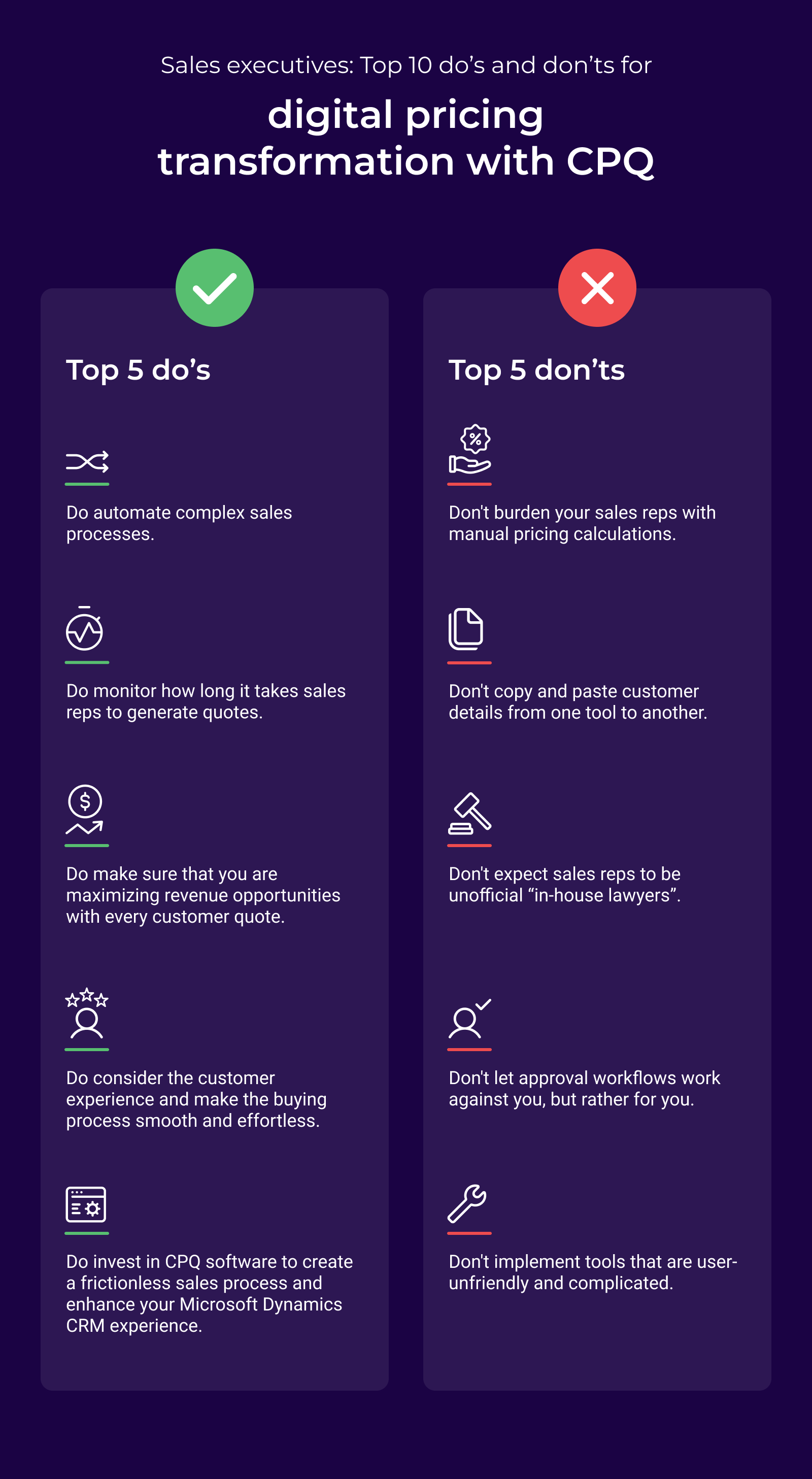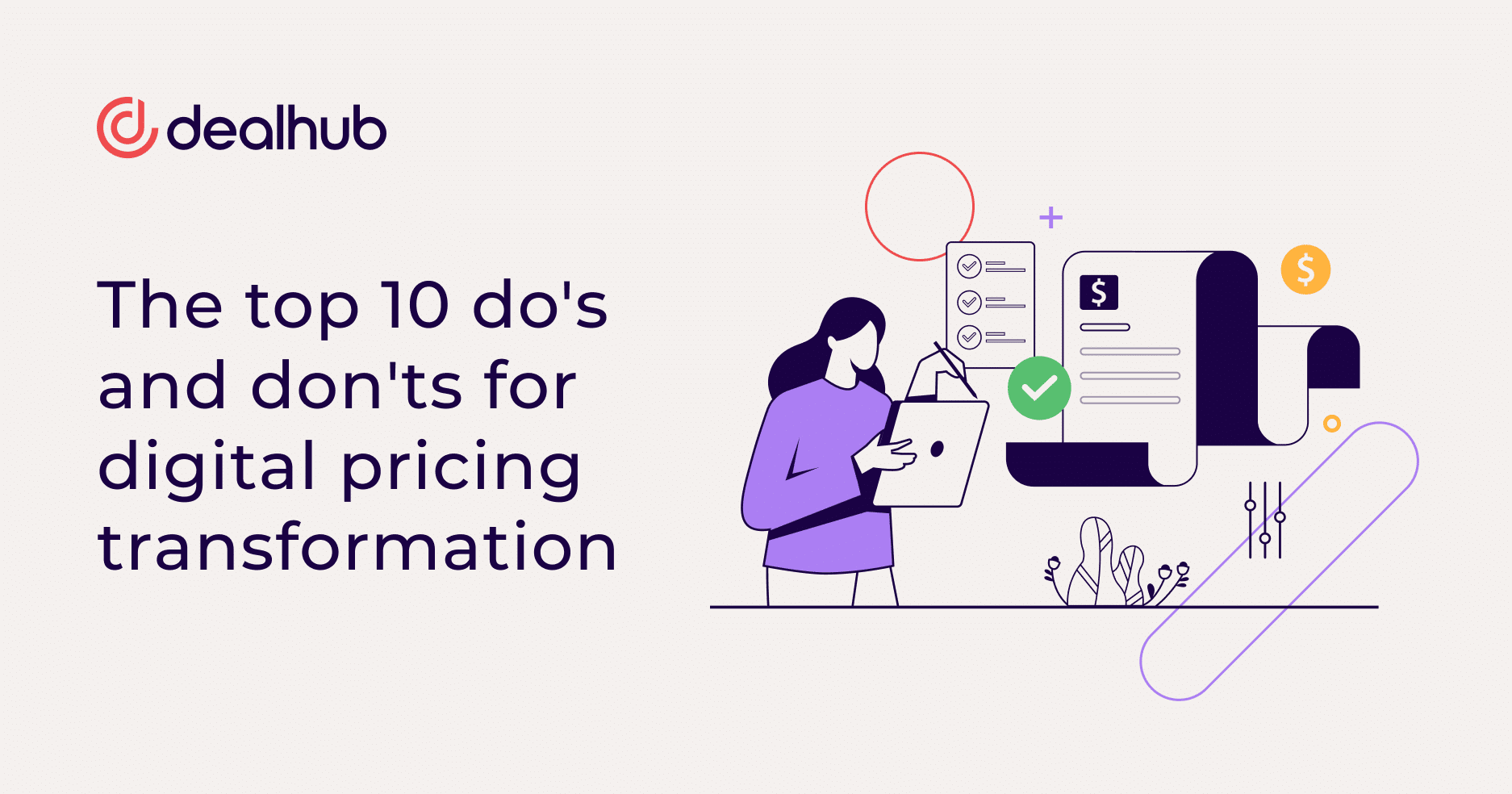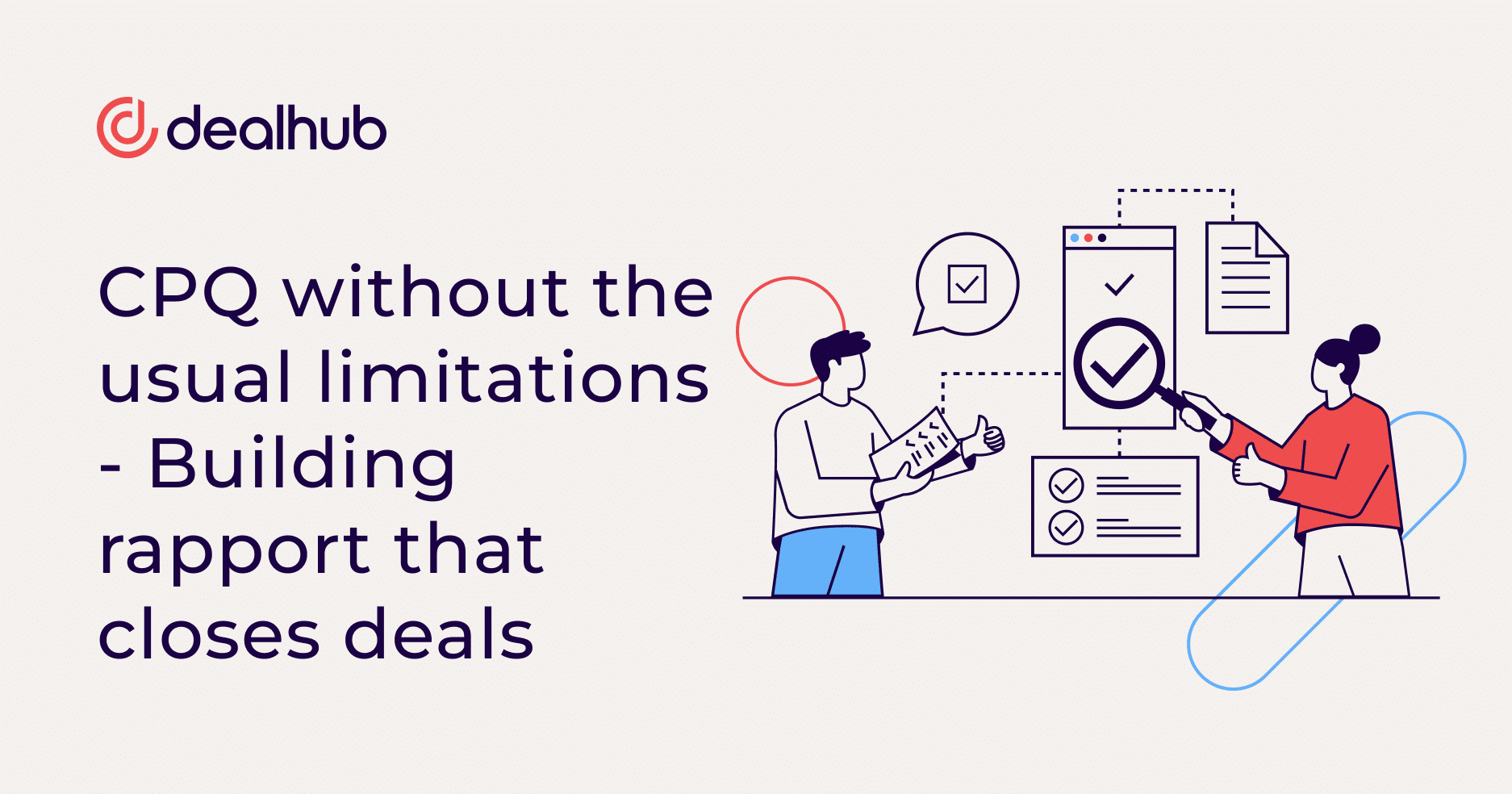So, how can you lead your team through a digital pricing transformation and come out of it with a pricing system your team will love? Below, we explore the challenges Sales Executives face with pricing complex products and services, focusing on Microsoft Dynamics users and reveal the top 10 do’s and don’ts every Sales Executive should know about when embarking on their digital pricing transformation with CPQ.
Pricing challenges in Microsoft Dynamics CRM
Microsoft Dynamics CRM is a fantastic tool for sales teams. It can help organizations manage their client database, engage with customers, generate leads, and more. It’s also one of the most intuitive CRMs, making it a popular option with various marketing and sales teams.
However, without the added layer of Configure, Price, Quote (CPQ), using Microsoft Dynamics CRM to generate complex quotes is challenging. CPQ software is designed to handle the complexities of configuring products, determining accurate pricing, and generating quotes. And, without the guiding hand of CPQ software, organizations using Microsoft Dynamics CRM may encounter the following challenges:
Manual configuration errors. Relying solely on a CRM, there’s a higher risk of manual errors in configuring complex products. Sales teams may struggle to accurately determine the right combination of features, options, and specifications, leading to incorrect configurations.
Inconsistent pricing. Maintaining consistent pricing across various products and services can be challenging without automated tools. Manual pricing calculations may result in inconsistencies, leading to potential revenue loss or customer dissatisfaction.
Time-consuming quoting processes. Creating quotes for complex products can be time-consuming. Sales teams may need to spend significant time gathering product information, calculating prices, and preparing customized quotes, slowing the sales cycle.
Limited cross-selling and upselling opportunities. Identifying cross-selling and upselling opportunities becomes more difficult without automated tools that analyze customer preferences, historical data, and product configurations.
Difficulty in managing discounts and promotions. Manually managing discounts, promotions, and pricing strategies can be error-prone. Without the ability to automate and action predefined rules, it’s hard for teams to ensure accurate and consistent application of pricing strategies.
Complex product catalog maintenance. Maintaining a complex product catalog within Microsoft Dynamics CRM may become cumbersome. Keeping track of product updates, changes, and discontinuations can be challenging without automation.
Lack of real-time pricing updates. Product and service prices may change frequently due to market conditions, supplier costs, or promotional events. Without real-time updates, sales teams may quote outdated pricing information, leading to potential revenue loss or pricing inaccuracies.
Limited scalability. As the product and service portfolio grows, manually managing pricing for many products becomes increasingly challenging and time-consuming.
Risk of proposal errors. Manually creating proposals and quotes increases the risk of mistakes in terms of product configurations, pricing details, and terms and conditions. This can negatively impact the company’s professional image and lead to customer dissatisfaction.
Integration challenges. Integrating Microsoft Dynamics CRM with other systems, such as ERP (Enterprise Resource Planning) or billing systems, may be more complex without CPQ software. Seamless integration is crucial for ensuring accurate order fulfillment and financial processes.
While Microsoft Dynamics CRM offers robust customer relationship management capabilities, leveraging a CPQ solution alongside it can significantly enhance the efficiency and accuracy of pricing complex products and services.
CPQ is the answer to your pricing woes
If your company struggles with complex pricing, CPQ may be the missing link for your sales team. CPQ software ensures accurate product configuration by guiding users through a structured process. It helps sales teams and customers choose the right features, options, and specifications, reducing the risk of errors in complex product configurations. CPQ provides dynamic pricing so teams can consider multiple factors (such as product features, customer segmentation, volume discounts, and market conditions) to ensure pricing accuracy. The tool also creates consistency across sales channels.
But CPQ offers so much more! Integrating CPQ allows for:
- real-time price adjustments
- automated discounting based on predefined rules
- identification of cross and upselling opportunities
- improved proposal accuracy
- faster quote generation
CPQ supports various pricing models (such as cost-plus, value-based, and competitive pricing) to allow companies to implement the pricing strategy that best fits their business model while enhancing collaboration between teams by centralizing data and communication.
Best of all, CPQ is scalable, so it grows alongside your business, ensuring that, even as your portfolio expands, it’s in lockstep with you, accommodating increased complexity.
Now that we’ve piqued your interest in CPQ, we’re not going to leave you hanging wondering how to successfully transform your pricing workflows with CPQ. Read on for the best practices for digital pricing transformation with CPQ.
Top 5 do’s when deploying your digital pricing transformation with a CPQ for Microsoft Dynamics CRM
With years of experience working with top Sales Executives, we’ve gathered some hard earned insights for you to learn from and help you avoid these common mistakes. To guarantee your digital pricing transformation is a success, make sure you’re following these five critical “do’s” to streamline your sales process, eliminate mistakes and errors, and improve the seller and buyer experience.
1. Do automate complex sales processes
Complicated sales processes easily frustrate sales reps, lead to lost time, and potentially lost deals. For example, reps may find it difficult to generate quotes accurately, especially if working with multiple SKUs for the same product, which can ultimately lead to lost revenue. Quote generation can be a tedious process and also be full of inaccuracies. It’s crucial to automate key parts of the sales process, like quote generation, to ensure a frictionless seller experience.
2. Do monitor how long it takes sales reps to generate quotes
It’s important to frequently monitor and be attentive to how long it takes your sales reps to create quotes. There’s a significant probability your clients are having to wait longer than is reasonable or advantageous to closing deals faster. While sales velocity and generating quotes quickly is important, speed isn’t everything. It’s paramount to your organization’s credibility that quotes are accurate as well.
3. Do make sure that you are maximizing revenue opportunities with every customer quote
Your sales team should be maximizing every revenue opportunity when generating customer quotes. The best way to accomplish this? Ensure your sales reps are offering customers optimal packages to maximize revenue. With guided selling, sales reps are provided with the best possible product bundles, including upsell and cross-sell bundles, to ensure your sales team is maximizing revenue.
4. Do consider the customer experience and make the buying process smooth and effortless
Long and drawn out sales processes that slow down the negotiation phase can result in lost deals and reduced organizational credibility. Gartner research shows, “delivering a great experience to prospective buyers has the biggest impact on whether or not they will buy something. The overall buying experience actually outranks product and price.” With that being said, it’s important to ensure your sales reps are providing customers with prompt and efficient service so customers can fully trust that quotes will always be done accurately and quickly in the future.
5. Do invest in CPQ software to create a frictionless sales process and enhance your Microsoft Dynamics CRM experience
CPQ software improves the seller and customer experience by optimizing the sales process, minimizing administrative work, and ensuring the delivery of accurate and prompt quotes to the customer. Modern and powerful CPQ software also measures customer engagement, tracks deal progress, and gives sales process insights to act on. In the current B2B sales environment, filled with complex and sometimes fragmented sales processes, CPQ software is a must in order to enhance your Microsoft Dynamics CRM experience.

Top 5 don’ts when completing your digital pricing transformation with a CPQ for Microsoft Dynamics CRM
Sales reps are either taught strategies and tips or they presume that certain actions are acceptable. Unfortunately, many of these employees are doing the incorrect things and, as a result, are not experiencing the desired outcomes. This is not a problem they created; but a problem technology created for them. Make sure your sales team is avoiding these top 5 “don’ts” when making your digital pricing transformation.
1. Don’t burden your sales rep with manual pricing calculations
Manual pricing calculations are risky, as it opens the door to human error and mistakes. Sales reps can potentially create quotes and contracts that either undercharge or overcharge the customer. And manually calculated pricing discounts also bear the possibility of error.
CPQ technology takes the guesswork out of manual pricing calculations. All the sales rep has to do is input the correct product packages and CPQ software calculates all pricing and discounts automatically. Automated approval workflows are sent to the appropriate department when pricing and discounting fall outside of predetermined guidelines set by administration.
2. Don’t copy and paste customer details from one tool to another
As mentioned above, manual tasks that allow for human error can lead to lost revenue. Pasting customer details from one tool to another – also known as “chair swiveling” – is ineffective, time consuming, and error prone. With automated synchronization between your CRM and CPQ software, you eliminate the opportunity for your sales reps to make unnecessary and costly mistakes.
3. Don’t expect sales reps to be unofficial “in-house lawyers”
Sales reps should not be creating their own contracts, and this also applies to changes made to Terms and Conditions during the negotiation process. CPQ software allows your legal department to set legal standards and make changes on their own, safeguarding sales reps from making changes themselves. Legal can rest assured that every contract sent is approved by them, even if changes need to be made after the quote is sent.
4. Don’t let approval workflows work against you, but rather for you
Internal processes should not slow down the sales process. For example, approval workflows should not delay sales reps from “passing on the baton”. Various departments that need to be brought into the process are seamlessly looped in via the CPQ solution. Moreover, automated approval workflows remove unnecessary back and forth communication and confusion that can hold up the quote-to-close process.
5. Don’t implement tools that aren’t user-friendly and complicated
If you want 100% sales team adoption, don’t implement CPQ software that is not user friendly and complicated to use. Remember, CPQ software should streamline and automate key parts of the sales process, not frustrate your sales teams. The solution needs to be quick to implement, modern, and most importantly – easy to use!
Provide a frictionless sales process with a CPQ for Microsoft Dynamics CRM
When embarking on digital transformations many leaders mistakenly think it’s all about the solution you implement. Our hard-earned insights and experience has shown, more often than not, that it’s about the processes that underlie the solution choice. Is it simple enough? Is the logic right? Does it leave room for my specific organization’s context?
With CPQ software, like DealHub CPQ, you can easily avoid many of the aforementioned “don’ts” easily anscd efficiently. DealHub CPQ automates nearly every aspect of the sales process, eliminates human mistakes and errors, and provides your sales team and customers with the most modern and efficient sales journey.
When completing your digital pricing transformation, it’s crucial to integrate DealHub CPQ software with your current Microsoft Dynamics CRM. By doing so, Sales Executives can eliminate manual pricing calculations, copying and pasting from one tool to another, unprofessionally generated quotes and contracts, and ineffective communication and approval workflows.









